| Stein Collectors International, Inc. |
| ~ German Kinderkrüge ~
(Children's Beer Mugs and Steins) by Stephen Lee Smith, SCI Master Steinologist with editorial assistance by Walt Vogdes, SCI Master Steinologist "For the Tuohy Children" |
 |
First a word about German/English terminology: The German word for children (pl.) is "Kinder"; the word for stein is Krug (pl., Krüge or Kruege) and the word for children's stein is Kinderkrug (pl., Kinderkrüge or Kinderkruege). Although it is frequently useful to adopt German words for English expression, thereby retaining a sense of context, culture and history for the term or expression, we must be careful not to construct new words using standard English practice, which would thereby have no legitimacy in either language. In German, all nouns are capitalized, and plurals are formed by special rules, not simply by adding an "s". In other words–
- "Kinder" (children), yes; "kinder", no.
- "Kinderkrug (children's stein), yes; "kinderkrug", no.
- "Kinderkrüge" or "Kinderkruege", yes; "Kinderkrugs", no.
The reasons why I started collecting Kinderkrüge.
My father was an automobile insurance executive and, as such, went to several large conferences a year. Every time he went to one, I would anxiously await the arrival of the ‘goodie bag’ he would bring home for me. One bag in particular seemed like it was huge, at least as I remember it now in my grown up mind. It was full of advertising gimmicks, paper, matchbooks, pens, pencils, “pin backs,” and candy that all the convention displayers had free for the attendees, but I thought of it as treasure! It was later in life that I found out that it is second nature to buy and bring home as a gift some small token of affection for the children, and sometimes for the wife. This keeps the child in anticipation and helps keep the parent in high esteem as a gift giver.
I now assume the German children of long ago got much pleasure from their parents, and even grandparents, when they were presented with these little mugs or steins as my father used to surprise me. Perhaps other members of the family gave them as gifts for birthdays and when they returned from trips, too.
As I started collecting beer steins, these “little guys” always caught my eye at flea markets, but as they were usually inexpensive pottery ones and I was known (or wanted to be known as) a collector of the finer “stuff,” I would always look at them and return them to the table.
It was at a “Stein Happening” at Ron Fox’s home in New York in the summer of 2002 that the thought of starting a new collection of steins overcame me. Seeing some of these on a for sale table, I felt I was missing out on a lot of collecting effort that I could really have fun with, and a pretty inexpensive effort at that. That is when I decided to add one more "sub-set" to my collecting effort and start collecting “Kinder beer mugs and steins.” Now when the “Great Spirit” calls me to the “Happy Hunting Grounds,” I hope one, or possibly all, of the Smith descendants might pick up on this part of my hobby and pass it along to the next generation.
I have collected lots of different things since I started collecting steins and other antiques in 1970. The list is too long to go into here, but every couple of years or so I just get tired of whatever I’m “into” at the time. I will then revert back to the old favorite: beer steins. So this is the second reason, I was done with collecting brass “china” boxes and this time around it was back to the basics, i.e. slip poured and molded pottery steins; nothing elaborate like silver or scarce like Guard Corps “Reservists” for me; just simple little clay mugs and steins small children and pre-teens would have liked and used back in their German homeland.
History
German parents of old were no different than modern ones here in the USA. When they went on trips, they would wish to bring home something for their children. So the parents would naturally think to bring home something to [a] remember the trip by, and [b] to amuse the kids with. As much as older German kids drank beer from the time they could sit at a table, and no one thought anything of it, a small stein was a good choice.
Twentieth century Germans might mix beer and coke at a 50/50 ratio for their child (1). “...In Germany, Kinderkrüge were made especially for children to drink beer. Beer? Yes, it was considered a 'health drink' just as grain beverages, 'Postum' and others are made in America, and elsewhere. In some parts of Germany, even today, the custom of drinking for children, in rationed quantities for health, is still practiced. 'Kraft Perle', a malt beer is a favorite among convalescents, old people and undernourished children.” (2)
It could be argued that some older German ‘wanderers’ just bought these Kinder mugs for themselves, as some of us Americans in the late 20th century collected refrigerator magnets or whiskey shot glasses to display at home, showing where we had been. These little mugs were certainly small and sturdy enough to survive and large enough to be recognizable from a distance when on display.
 Kinder steins and mugs are not considered "miniature"
steins in my mind. While the question can and has been debated (see Les
Paul’s article in Prosit, the journal of Stein Collector’s International,
September 2003), most collectors of miniatures that I know do not consider these
Kinder mugs and steins to be “miniatures” per-se. They generally collect
steins which are smaller than 1/8 liter, the most common size for Kinderkrüge.
Certainly a ¼ liter beer stein (appropriate for a pre-teen) could not be
considered a miniature. Figure 1 is a typical 2 ¾ inch tall salt glazed stein
that would be considered a miniature but not a Kinder. It was produced to be
displayed, not for use. In contrast, all Kinderkrüge were meant to be used.
Kinder steins and mugs are not considered "miniature"
steins in my mind. While the question can and has been debated (see Les
Paul’s article in Prosit, the journal of Stein Collector’s International,
September 2003), most collectors of miniatures that I know do not consider these
Kinder mugs and steins to be “miniatures” per-se. They generally collect
steins which are smaller than 1/8 liter, the most common size for Kinderkrüge.
Certainly a ¼ liter beer stein (appropriate for a pre-teen) could not be
considered a miniature. Figure 1 is a typical 2 ¾ inch tall salt glazed stein
that would be considered a miniature but not a Kinder. It was produced to be
displayed, not for use. In contrast, all Kinderkrüge were meant to be used.Souvenir - Places and Cities


 By far the biggest souvenir mug-stein business was in Munich, and
Heidelberg probably next. The most common Heidelberg scene shows the castle on
the mount. All other major German cities such as Berlin and Cologne (Koln) had
their own versions. Of course, Kinders from nearby countries such as Holland and
Belgium can also be found.
By far the biggest souvenir mug-stein business was in Munich, and
Heidelberg probably next. The most common Heidelberg scene shows the castle on
the mount. All other major German cities such as Berlin and Cologne (Koln) had
their own versions. Of course, Kinders from nearby countries such as Holland and
Belgium can also be found.
Smaller sights such as “Drachenfels” and “The Rheinstein”, the famous mountain and castles on the Rhine and other major rivers also were popular souvenirs. The National Monument at Rüdesheim is seen a lot, also.
Of course American cities are no exception to these wares. Kinder mugs can be found from New York, Washington D.C., and even smaller USA cities such as Indianapolis and Lexington Mass., whose 4.5 inch mug, shown at right above, sold on Ebay on 3/23/03 for $201.50!


Souvenir - without building scenes
A subset of souvenir mugs are found with other decorations on them that do not pertain to the city or town the mug is a souvenir from. This one shows angels with their music, and is marked below the rim “Gruss aus d-Dechenhöhie”. Others are city stamped on the bottom of the mug.
Fairy Tales (Ger.: die Märchen)



Left above we see Snow White (Sneewittchen), while at center and right are two variations of (Little) Red Riding Hood (Rotkäppchen = ‘Red Cape’). Red Riding Hood scenes far exceed any other fairy tale mug / stein produced. Look at the size of that wolf on the stein in the middle! It is interesting to note that the body on this stein showing a grandmother surrounded by five children was still being produced on a series of Kinder mugs during the modern era of “Western Germany”.



Both of these steins show characters from Hansel and Gretel. The stein shown at left and center above is a ¼ liter size, which I consider to be for a "pre-teen". It comes in several variations, with the swirled flower designs to the side of the center scene being either painted or unpainted, and the center roundel may be found in both green and blue. The stein to the right shows the wicked witch of this tale, Knusperhexe.
Below we see two scenes from Sleeping Beauty (Dornroschen).


Other fairy tale themes which may be found on Kinders include Puss 'n' Boots, the Pied Piper (Rattenfänger, or Rat Catcher), Cinderella, St. Nikolaus or Wiehnachtsman (Santa Claus), the Goose Keeper Girl (Gänselisl). We find other examples which must have a tale behind the scene, but the meanings are so far unclear (see below).



The left and center figure above show a frog taking a photographic portrait, while at the right two small creatures appear to be having some sort of dispute. She’s a mouse -- but what is he?

I suppose the reason for all the “happy couples” that end up on these vessels is the idea of conveying the happiness between the two parents that presented the child with the gift. I can come up with no other reason for the vast amount of mugs/steins displaying this motif. I estimate that at least 15 to 20 per cent of “Kinder” pieces show this type of scene. Most of them show a couple just sitting and talking to each other, which is pretty much how I think it must have been in the late 19th century.

 A subset of this
theme is steins showing dancing couples. Again, I suppose the idea was to
portray a happy couple. The center stein at left shows a man and a woman engaged
in a favorite German dance, the Schuhplattler. (Although they would
undoubtedly have loved it, this is "The Shoe Slapping Dance", not
"The Chicken Dance.")
A subset of this
theme is steins showing dancing couples. Again, I suppose the idea was to
portray a happy couple. The center stein at left shows a man and a woman engaged
in a favorite German dance, the Schuhplattler. (Although they would
undoubtedly have loved it, this is "The Shoe Slapping Dance", not
"The Chicken Dance.")
Playing of the accordion, or a small harpsichord, or the lute are additional examples of this peaceful, harmonious family scene. At far right above, a mother teaches her daughter how to play a stringed instrument.
The mug in the middle showing the couple dancing is from a series of "Kinders" produced by the firm of Marzi & Remy in the 2900 series of design [mold] numbers.
Even the famous stein producing firm of V & B Mettlach produced a 3/10th liter stein for the kids (form number 2057). It shows peasants dancing in line, while holding their overflowing beer mugs.
Heinzelmännchen
This is the German name for their “secret people”, seen to the left below playing instruments and drinking. (See the in-depth article in Prosit [the journal of Stein Collector’s International], No. 101, by Floyd Dietlein and Roland Henschen, September 1990.) The second stein below again shows the “little ones” pulling a sled with a fir tree at Christmas season.

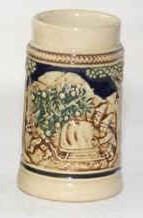

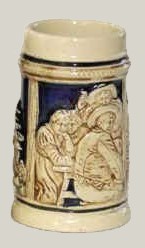
Folk Scenes
Franz von Defregger’s scenes of Tyrolean life are perhaps the most popular of the folk scenes found on all types of beer steins and mugs, not just Kinders. The two mugs to the right above show scenes adapted from Defregger paintings. Defregger was born on 30 April 1835 in Stronach, Tirol, on the so-called Edererhof. He was a painter of Austrian genre and historical scenes. He studied in Munich with Piloty. He is most known for his popular pictures of Tyrolean life, which depend largely for their interest on their fine characterization and humor. Good examples are "The Last Summons" and "Zither Player" (both: Vienna). He died on 2 January 1921 in Munich. (3)
Religious and Historical
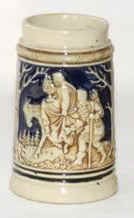

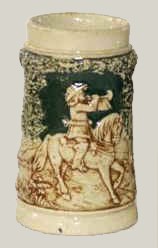 Mary (on donkey) and Joseph, going to Bethlehem, shown on the left
above. To the right of that Kinder are two Kinders with Greek-Roman warrior
portraits on the sides, flanking one which depicts Hermann, the German, hero of
the battle of Teutoburger Wald (9 AD). “Kinders” purchased in the U.S.A.
might include famous real Americans. The German pottery firm of A. Diesinger
made a .25 liter with the face of “Chief Red Cloud” represented.
Mary (on donkey) and Joseph, going to Bethlehem, shown on the left
above. To the right of that Kinder are two Kinders with Greek-Roman warrior
portraits on the sides, flanking one which depicts Hermann, the German, hero of
the battle of Teutoburger Wald (9 AD). “Kinders” purchased in the U.S.A.
might include famous real Americans. The German pottery firm of A. Diesinger
made a .25 liter with the face of “Chief Red Cloud” represented.
Siegfried and the Dragon may be found, along with many other characters or scenes from opera, poetry and legend. The farewell scene from Victor von Scheffel's love poem "The Trumpeter of Sackingen" is shown to the right.
This is most often seen with the relief of a small child or maybe a trio of youngsters. This implies: “If you are a good kid we will give you a little of the 'hops juice.'"

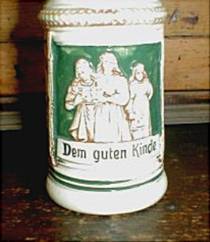

As stated before, these mugs, because of their durability, were used for any liquid the parents or grandparents wished the child to drink, even wine on special occasions (4).
Miscellaneous
Always an interesting category as one never knows what one might find “out there”. In this category I place steins with only a German phrase such as Wohlbekomms (below, left), Zum Andenken and Ein Trunk macht jung. We also find a depiction of hunting dogs engaged with a wild boar or deer (center), and little angels delivering Christmas items to a home's door (below, right). A Tannenbaum (Christmas Tree) is on the sled being pulled by deer.
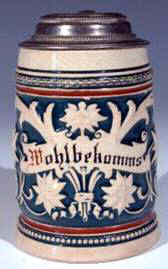
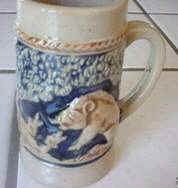

“Freebies - Advertisiing
Seen in this category are Kinder steins and mugs that advertise buildings or products. A good example is a .25 liter slip mold showing figures in German costume, with the words “Horlacher, 9 Months Old Perfection Beer” [sold on eBay for a whopping $93 back in May 1992].
There is a series of “Kinder mugs” that back in the 1970’s to the 1980’s came as premiums with the purchase of vinegar or mustard from the German firm of “Jo-Mo” (with a stamped blue and white paper seal). These are very distinct in their lack of crisp detail, and having only two side scenes; but a lot of them show fairy tales, therefore are highly collectable. The numbering system that has been seen stamped into the bottom of these mugs ranges from #3957 to #4092 (and maybe higher or lower). Shown below are numbers: 3958, 4001 and 4088.
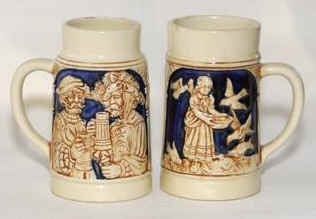
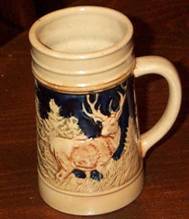
Pre-Teen Steins
Mostly ¼ liter; Types seen: Defregger, Historical, Heinzelmännchen, and the older folk and more advanced fairy tales/legends and also famous German paintings such as “Rembrandt”. The ¼ liter stein shown at left below is entitled "Die Soldaten" (the soldiers); next is "Rembrandt"; then two steins bearing Defregger scenes.


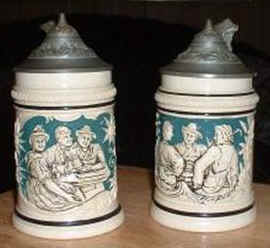
Origin Markings of Kinder Steins and Mugs
[a] No country stamp/markings Perhaps the oldest, meant for use inside Germany, no export
[b] “Germany”. Stamped thus to meet USA import laws. As there were lots of German children within the USA, this would have been a lucrative little business. This word was stamped on all steins regardless as the manufacturer couldn’t be certain which lot of steins produced by his firm would stay in Germany.
[c] “Made in Germany”. I have seen many different starting dates written for this USA import mark change; I’m sticking with 1912 for now, until someone shows me an actually document; it lasted until October 1949.
[d] “Made in Western Germany”. Mark used after WWII, when Germany was split into two very separate and political jurisdictions, between October 1949 and October 1990,
[e] “Made in Germany” [II], Started again sometime after October 1990, after the reunification of the two Germanys.
Makers
Most makers are unknown due to no markings. “Marzi and Remy” did a series with alpine house on both sides of mug. Various center scenes. (See right in “Dancing Couples” –above)
Some marked: “FOREIGN”
Further examples of Kinders are shown below.
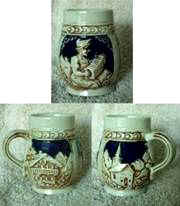 |
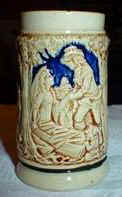 |
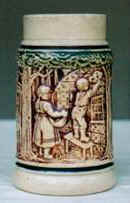 |
| Squeeze Box Player | Sleeping Beauty | Hansel & Grethel |
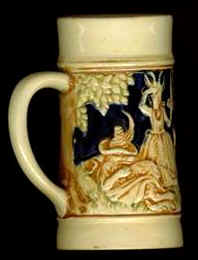 |
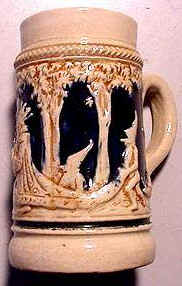 |
 |
| Unknown Fairy Tale | Heinzelmännchen | Domestic bliss |
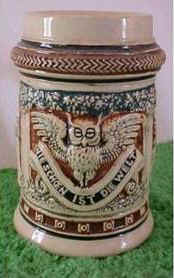 |
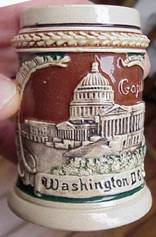 |
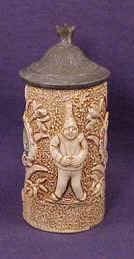 |
| "How pretty the world is" | The U.S. Capitol | Diesinger clown |
NOTE: Most Kinders shown in this article are in the Stephen Lee Smith Collection: “From Which to Drink”:
FOOTNOTES:
(1) Email from Gunther Knickel to Stephen Smith, November-2002
(2) Excerpt from “And A Child Shall Lead Them”, article by Leonce Miller, in PROSIT, (the magazine of Stein Collector’s International), page 628, Dec.1979
(3) From: Encyclopedia @ Infoplease.com
(4) Email from Les Paul 12-18-2002: Steve, The ones I can figure out are 15 different Little Red Riding Hoods (Rotkappchen); 7 different Sleeping Beauty's (Dornroschen); 6 Snow Whites (Schneewittchen); 3 Hansel & Grethels; and 3 with Mary on the donkey with Joseph going to Bethlehem. These are all 1/8th liter size steins. All the children related steins seem to be this size and I think they were meant to be used by kids. 100 years ago, kids were given a little beer to drink with meals. Beer is, or was, thought of more as a liquid bread or food than an alcoholic beverage. My Grandparents gave me a small portion of beer, and on a special occasion, wine with meals as early as I can remember; but they would never let me try schnapps or strong drinks. Les 12-18-2002
|
All rights reserved. |